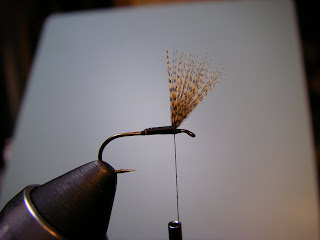You can tye this fly on any standard dry fly hook in sizes 12 down 18 are the best.First start by putting the hook in your vise and start the thread.For this one this one I am using 8/0 black uni thread and tying on a size 12 Mustad dry fly hook. Note the start position of the thread I always start my thread here to set my wings by doing so will keep your wings a consistent hight and will prevent you from crowding the head.
Next choose a nice lemon wood duck feather strip all the fuzz off the bottom half till you are left with the nice even tips.
Now stroke all the fibers together to prepare to tye in.
Once you are done making a nice little bundle of fibers it's time to measure your wing up and tye it in. Leave the tips of the feather hang out past the hook eye 3/16ths to 1/4 of an inch.
After you have tied the wing in with a few secure wraps trim the waste and finish neatly tying it in.
Now it's time to get the wing standing upright.This is accomplished by grasping the wing and pulling it straight up and wrapping your tying thread in front of the wing . This creates a small dam of thread which helps to hold the fibers up.
Now that you have your wing standing up it is time to separate the fibers to create two wings.By pulling the wing fibers into two some what even bunches . Pass your tying thread between them using the figure 8 method. This will keep them separated into two wings.
Once you have your wings divided wrap your thread in nice even wraps towards the bend , stop your thread between the barb and the point of the hook.
It's time to tye in the tail good stiff tailing hackle is imperative to get that nice straight tail.I have started using Coq De Leon it comes in an array of colors and provides a nice stiff hackle for tailing dry flies.On this fly I used a dark dun Coq feather and it matches up pretty nice with the hackle I used to tye this fly. Take your feather and pull off enough fibers to create a nice tail.
Measure up your tail it should be the length of the entire hook.
Now that you have measured it up trim off the waist end and tye in. When you tye it in hold it up to the fly and tye in so the butt ends blend into the butt of the wing tye in point ,this will give you a nice some what even body profile.
Now that the tail is tied in it is time to select prepare and tye in a stripped peacock quill. Choose a nice quill from close to the eye of a quality peacock eye feather.To strip these I use my thumbnail and index finger . I pull the quill between them untill all the fibers are removed. You can also use a rubber eraser to do this as well.
Once your quill is stripped it is time to tye it in and wrap your body.Tye in nice and neat and wrap forward to the thorax area in nice even touching wraps. Tye off and clip the waist end close and there your body is complete.
Now that the wings , tail and body are done it is time to complete the fly by tying in the hackle.Choose an appropriate size hackle for your fly.If you are not sure of the size use your hackle guage. I am tying on a size 12 hook so I usually use a hackle 1/2 to one full size larger than the hook calls for. In this case a size 12 1/2 to 13 hackle.
Strip the end and tye in, I like to leave the exposed stem a little long so when you tye it in you catch a little more of it making your fly durable .
Now it's time to wrap the hackle three to four wraps behind the wing is about right.
And then two to three turns in front or the wing and tye off. As you tye off hold the hackle vertical to the hook shank this helps to eliminate trapped hackles.
Trim the waist end and whip finish.










































Lovely fly al as usual. Top notch step by step too
ReplyDeleteExcellent how to post.
ReplyDeleteA classic Catskill pattern very well done.
Thank you Jamie and Brk Trt! It's a lot of fun putting these together I'm glad you like it!
ReplyDeleteGreat instruction, thanks. If I wanted a Red Quill, is it just using a different rib rather than the peacock?
ReplyDeleteHello Agiocochook,
ReplyDeleteYes you would tye a red quill the same way but using a stripped road island red hackle quill. Or you can purchase stripped dyed quills just be sure to soak them before tying. This will keep them from splitting, let the fly dry overnight and give it a good coat of head cement on the body.
Allen